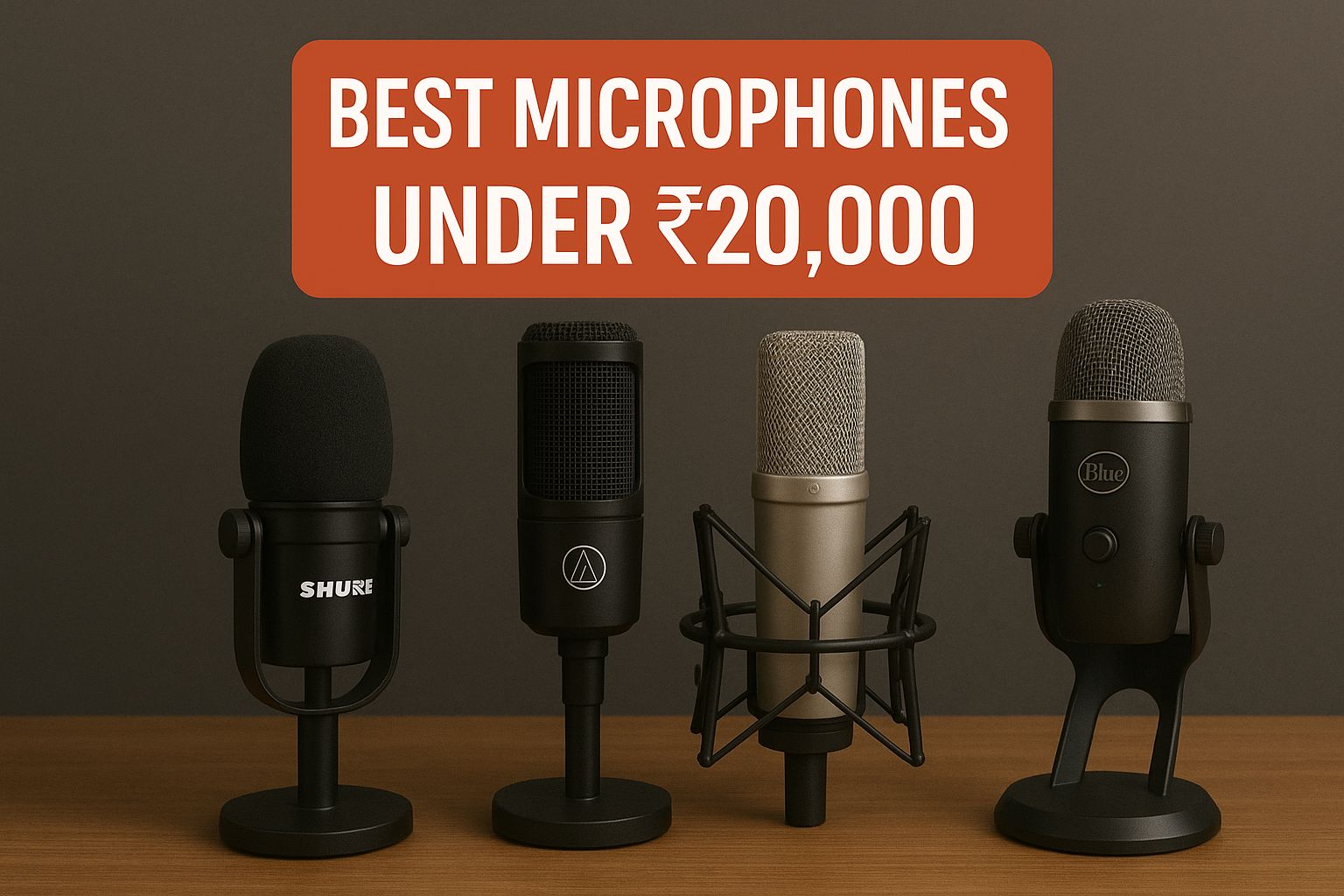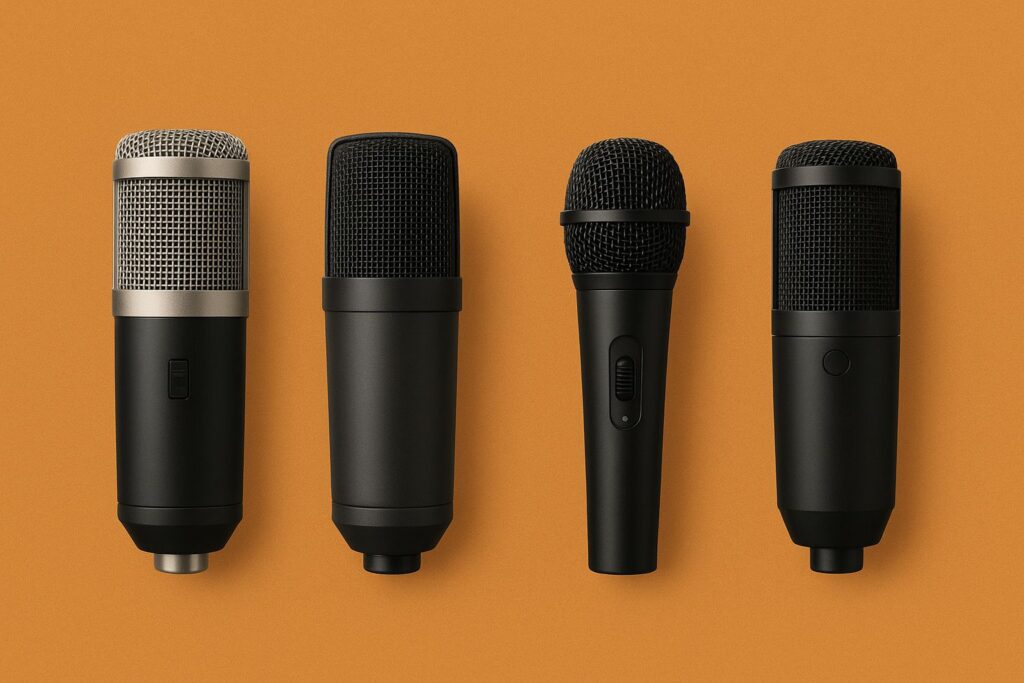- You have no items in your shopping cart
- Subtotal: ₹0.00

Alright, you want solid mics that don’t break the bank but still sound great. Cool. I’ve tested, compared, and lived with a bunch of these over the years, and what I’m sharing here is practical: when to pick what, what surprised me, and what I’d change next time.
I’ll list more than ten models that commonly fit and best microphones under ₹20k ceiling and explain real use-cases for each. I won’t pretend there’s one “best” mic – there isn’t.
Quick primer (so you don’t waste money)
- USB vs XLR: USB = instant plug-and-play (great for quick streaming/podcasts). XLR = more flexible long-term (you’ll need an interface, but it generally sounds better).
- Condenser vs dynamic: condensers are sensitive and detailed, awesome in treated rooms. Dynamics are tougher and better for noisy environments or close-mic speech.
- Accessories matter: good boom arm, pop filter, and/or shock mount will improve recordings more than a tiny step up between two similar mics.
- Match the mic to the room. If your room is untreated and noisy, a dynamic is often a smarter first buy than an expensive condenser.
My top picks (models I actually recommend for creators under ₹20k)
MAONO PD400X (hybrid USB/XLR)
A practical hybrid – USB for quick use and XLR if you upgrade later. Cardioid pattern, easy controls on the body. I liked it because it let me start on USB and switch to an interface later without buying a new mic.
Audio-Technica AT2040 / AT2040USB
A broadcast-style dynamic that handles close-talk well and kills room noise. If you stream from a small bedroom with a laptop, this style is forgiving and gives that “radio” voice.
Audio-Technica ATR2500x-USB
Audio-Technica ATR2500x-USB Cardioid Condenser USB Microphone
A simple USB condenser that’s plug-and-play. Not my go-to for untreated rooms, but for quiet voiceover or podcasting it’s quick and clean.
Audio-Technica AT2020 (XLR)
Audio-Technica AT2020 Cardioid Condenser Studio XLR Microphone
A studio classic for project studios. Clear, balanced, and inexpensive for what it offers – best when paired with a decent audio interface and some basic acoustic treatment.
Shure SM57
Rugged and versatile. It’s famous for instruments, but it’s also a great workhorse for spoken word if you mic close. It’ll survive drops and road gigs.
AKG P120
A value XLR condenser – smooth and good for singers on a budget. If you have an interface and plan to record vocals, this is a sensible choice.
Rode Podcaster / Rode NT-USB Mini
Rode NT-USB Mini Studio Quality USB Unidirectional Microphone
Rode’s USB offerings are good for creators who want straightforward setup and solid build quality. The NT-USB Mini is compact and sounds nicer than its size suggests.
Shure MV51 / MV7 (digital/hybrid)
These give you Shure voicing and onboard DSP/presets. MV7 is great if you want both USB and XLR; MV51 is a sturdy digital desktop option for quick recording sessions.
Sony C-series condensers (e.g., C-60)
Sony’s small condensers are smooth and musical – nice for studio vocals when paired with proper phantom power and a good preamp.
Electro-Voice RE20 (watch for deals)
The RE20 is a broadcast legend. It sometimes sits above the ₹20k line, but on sale or second-hand it can fall into this budget. If you get one, it’s fantastic for close-miked speech and radio-style voice.
Starter USB kits (budget bundles)
There are several branded kits that bundle a USB condenser with a boom arm and pop filter. Quality varies, but they’re great for absolute beginners who need a ready-to-record package.
Use-case buckets – pick based on your real situation

- Noisy bedroom / streaming: go dynamic USB/XLR (AT2040 style or similar). You’ll get clearer voice with less room noise.
- Quiet treated room / singing: large-diaphragm condenser (AT2020, AKG P120, Sony C-series).
- Instruments and hybrid use: SM57 for guitar/amps; condensers if you want ambient detail.
- Absolute beginner on a budget: a USB condenser kit will get you recording immediately.
Practical tips from my experience
- Buy the ecosystem: a cheap condenser + bad USB hub + noisy laptop = garbage recordings. Invest in one good cable, a proper stand/arm, and a pop filter.
- Room > mic (most of the time): treating reflections or using a reflection filter made a much bigger audible difference for me than upgrading from one mid-tier mic to another.
- Try before you commit (if possible): borrow or test in a store. What sounds great for someone else may not suit your voice or room.
What I’d do differently next time
- I’d spend less on a flashy mic and more on isolation and an interface. For a lot of my projects, a dynamic mic + a small interface would’ve been the highest-impact purchase.
- I’d avoid buying multiple similar-sounding condensers early on. Instead, buy one versatile mic and upgrade the recording chain (preamp/interface, room treatment) first.
- I’d keep receipts and look for warranty/return windows – sometimes a mic just doesn’t suit your voice and you want the option to swap it.
Short checklist before you buy
- What’s your main use? (streaming, singing, podcast, instruments)
- Is your room treated? (yes → condenser is fine; no → consider a dynamic)
- Do you want instant USB or an upgrade path (XLR)?
- Budget for essentials: stand/arm, pop filter, cables, interface if XLR.
Final thought
If I had to recommend one “safe” choice under ₹20k for most creators who aren’t in a fully-treated studio: a hybrid or USB dynamic that’s durable and forgiving. It’ll get you clean, usable voice recordings fast and honestly, that’s more valuable than a slightly brighter condenser you can’t use properly in a noisy room.
Which is the best microphone under ₹20,000 for podcasting?
For most podcasters, a dynamic USB or hybrid mic like the MAONO PD400X or Audio-Technica AT2040USB works great because they handle background noise well.
Are USB microphones better than XLR for beginners?
USB mics are easier for beginners since they plug directly into a computer. XLR mics need an audio interface but offer more flexibility and upgrade options later.
What type of microphone is best for noisy rooms?
Dynamic microphones are ideal for noisy or untreated rooms because they reject more ambient sound compared to condensers.
Can I use these microphones for both vocals and instruments?
Yes. Models like the Shure SM57 or Audio-Technica AT2020 can handle both voice and instruments well with proper positioning.
Do I need extra equipment with these mics?
USB mics only need a USB cable, but XLR mics require an audio interface, stand, and pop filter for best results.
What’s the difference between dynamic and condenser microphones?
Dynamic mics are more rugged and reject noise better; condensers are more sensitive and detailed, perfect for treated studio spaces.
Which mic is best for live streaming under ₹20,000?
The Audio-Technica AT2040USB or Shure MV7 are strong choices for live streaming because they deliver clear sound with minimal setup.
Are there good condenser mics under ₹20,000?
Yes. The Audio-Technica AT2020, AKG P120, and Sony C-series models are excellent condenser options within this price range.
How important is room treatment when buying a mic?
Very. Even the best mic will pick up unwanted echoes and noise in an untreated space. For noisy rooms, choose a dynamic mic.
Can I upgrade from a USB mic to an XLR setup later?
Yes. Many hybrid models like the MAONO PD400X have both USB and XLR connections, letting you start simple and upgrade later.
